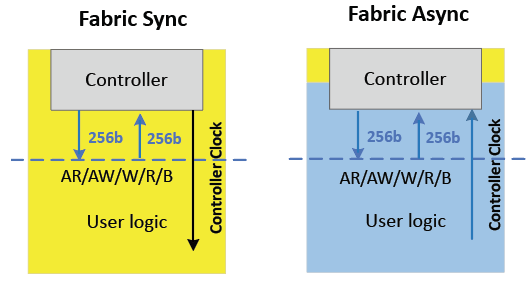Visible to Intel only — GUID: uei1699115621961
Ixiasoft
1. About the External Memory Interfaces Agilex™ 5 FPGA IP
2. Agilex™ 5 FPGA EMIF IP – Introduction
3. Agilex™ 5 FPGA EMIF IP – Product Architecture
4. Agilex™ 5 FPGA EMIF IP – End-User Signals
5. Agilex™ 5 FPGA EMIF IP – Simulating Memory IP
6. Intel® Agilex™ 5 FPGA EMIF IP - DDR4 Support
7. Intel® Agilex™ 5 FPGA EMIF IP - LPDDR4 Support
8. Intel® Agilex™ 5 FPGA EMIF IP - LPDDR5 Support
9. Agilex™ 5 FPGA EMIF IP – Timing Closure
10. Agilex™ 5 FPGA EMIF IP – Controller Optimization
11. Agilex™ 5 FPGA EMIF IP – Debugging
12. Document Revision History for External Memory Interfaces (EMIF) IP User Guide
3.2.1. Agilex™ 5 EMIF Architecture: I/O Subsystem
3.2.2. Agilex™ 5 EMIF Architecture: I/O SSM
3.2.3. Agilex™ 5 EMIF Architecture: HSIO Bank
3.2.4. Agilex™ 5 EMIF Architecture: I/O Lane
3.2.5. Agilex™ 5 EMIF Architecture: Input DQS Clock Tree
3.2.6. Agilex™ 5 EMIF Architecture: PHY Clock Tree
3.2.7. Agilex™ 5 EMIF Architecture: PLL Reference Clock Networks
3.2.8. Agilex™ 5 EMIF Architecture: Clock Phase Alignment
3.2.9. User Clock in Different Core Access Modes
Benefits of Each Access Mode
6.4.3.1. 1 Rank x 8 Discrete (Memory Down) Topology
6.4.3.2. 1 Rank x 16 Discrete (Memory Down) Topology
6.4.3.3. VREF_CA/RESET Signal Routing Guidelines for 1 Rank x 8 and 1 Rank x 16 Discrete (Memory Down) Topology
6.4.3.4. Skew Matching Guidelines for DDR4 (Memory Down) Discrete Configurations
6.4.3.5. Power Delivery Recommendation for DDR4 Discrete Configurations
6.4.3.6. DDR4 Simulation Strategy
11.1. Interface Configuration Performance Issues
11.2. Functional Issue Evaluation
11.3. Timing Issue Characteristics
11.4. Verifying Memory IP Using the Signal Tap Logic Analyzer
11.5. Generating Traffic with the Test Engine IP
11.6. Guidelines for Developing HDL for Traffic Generator
11.7. Hardware Debugging Guidelines
11.8. Create a Simplified Design that Demonstrates the Same Issue
11.9. Measure Power Distribution Network
11.10. Measure Signal Integrity and Setup and Hold Margin
11.11. Vary Voltage
11.12. Operate at a Lower Speed
11.13. Determine Whether the Issue Exists in Previous Versions of Software
11.14. Determine Whether the Issue Exists in the Current Version of Software
11.15. Try A Different PCB
11.16. Try Other Configurations
11.17. Debugging Checklist
11.18. Categorizing Hardware Issues
11.19. Signal Integrity Issues
11.20. Characteristics of Signal Integrity Issues
11.21. Evaluating Signal Integrity Issues
11.22. Skew
11.23. Crosstalk
11.24. Power System
11.25. Clock Signals
11.26. Address and Command Signals
11.27. Read Data Valid Window and Eye Diagram
11.28. Write Data Valid Window and Eye Diagram
11.29. Hardware and Calibration Issues
11.30. Memory Timing Parameter Evaluation
11.31. Verify that the Board Has the Correct Memory Component or DIMM Installed
Visible to Intel only — GUID: uei1699115621961
Ixiasoft
3.2.9. User Clock in Different Core Access Modes
The EMIF IP for Agilex™ 5 devices supports two user access modes.
- Synchronous fabric clocking, where the EMIF IP provides a user clock.
- The user clock frequency is limited by the maximum core-to-periphery (C2P) and periphery-to-core (P2C) frequency of 300 MHz.
- In DDR4, the user clock frequency will be one-quarter of the memory clock frequency ((mem_CK)/4).
- In DDR5, LPDDR5, and LPDDR4, the user clock frequency will be one-eighth of the memory clock frequency ((mem CK)/8).
- Asynchronous fabric clocking, where you provide the clock to the EMIF IP.
- The asynchronous user clock can come from any user clock source on the device.
- The user clock frequency has no dependency on the memory clock (mem_CK).
The following figures illustrate the different clocking styles available for the Agilex™ 5 EMIF IP.
Figure 10. Access Modes


Benefits of Each Access Mode
- Synchronous fabric clocking is required for DDR4 DIMM.
- Asynchronous fabric access mode has the lowest latency.
- Asynchronous fabric access mode can achieve higher memory clock frequency in some speed grade / protocol combinations.